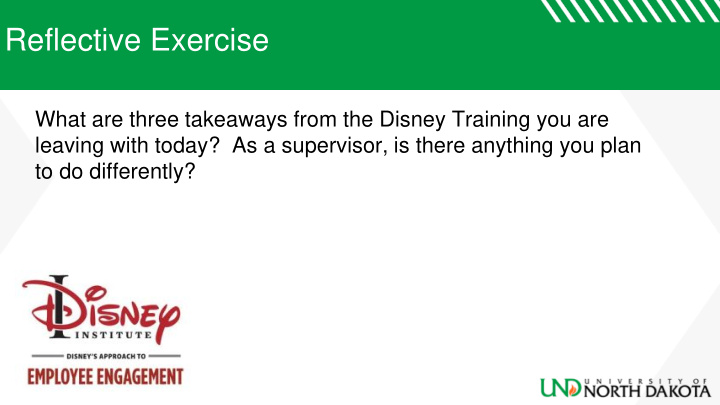



Reflective Exercise What are three takeaways from the Disney Training you are leaving with today? As a supervisor, is there anything you plan to do differently?
Enhance your Work Culture: Building Employee Engagement Wednesday, April 16
Engaged Employees defined by Gallup Engaged employees are those who are involved in, enthusiastic about and committed to their work and who contribute to their organization in a positive manner. • They are more productive, profitable and customer-focused
Difference between Engagement & Satisfaction Satisfied Engaged • May or may not be • Work with passion productive • Perform at consistently • Put their time not high levels necessarily their energy • Drive innovation and into their work move their • Take a wait and see organization forward attitude toward their job
Three types of Employees
Gallup’s Q12 – the 12 elements of engagement Q1: I know what is expected of me at work. Q2: I have the materials and equipment I need to do my work right. Q3: At work, I have the opportunity to do what I do best every day. Q4: In the last seven days, I have received recognition or praise for doing good work. Q5: My supervisor, or someone at work, seems to care about me as a person. Q6: There is someone at work who encourages my development. Q7: At work, my opinions seem to count. Q8: The mission or purpose of my company makes me feel my job is important. Q9: My associates or fellow employees are committed to doing quality work. Q10: I have a best friend at work. Q11: In the last six months, someone at work has talked to me about my progress. Q12: This last year, I have had opportunities at work to learn and grow .
Actively Disengaged Employee Engagement 13% of U.S. employees are Actively Disengaged These employees are: • physically present but psychological absent. • unhappy with their work situation • share their unhappiness with their colleagues; they Actively Disengaged Not Engaged Engaged insist on it
Not Engaged Employee Engagement 53% of U.S. employees are Not Engaged These employees may be productive, but they are: • not psychologically connected to their organization • more likely to miss workdays and leave the Actively Disengaged Not Engaged Engaged organization.
Engaged Employee Engagement 34% of U.S. employees are 13% Engaged 34% These employees are: • loyal and psychologically committed to the organization • more productive 53% • more likely to stay with Actively Disengaged Not Engaged Engaged their organization
Reflective Exercise/Small Group Exercise What behaviors do you expect to see exhibited by someone who • is actively disengaged? ( physically present but psychological absent) • is not engaged? ( productive, but not psychologically connected to the organization) • is engaged? ( loyal and psychologically committed to the organization)
What is our Role as Supervisors?
Reflective Exercise As supervisors, how can we: • address the negative behaviors of actively disengaged employees? • support the constructive behaviors of engaged employees? • create a culture that promotes positive engaged employees?
Lead with a Focus on Engagement: The Role of the Supervisor • Individualize your approach • Build trust and the right environment • Engagement every day • Engaging Conversations
Reflective Exercise What kind of questions should we be asking our direct reports to determine their engagement?
Employee Engagement Matters • Make Engagement a Priority • Constantly Focus on it • Understand and appreciate that each employee will have different engagement needs • Recognize that engagement is built on individual basis as well as team basis • Know engagement starts with you • Every moment matters
Questions? Thank you! Dr. Anne Kelsch – anne.kelsch@UND.edu Carrie Herrig – carrie.herrig@UND.edu
Recommend
More recommend